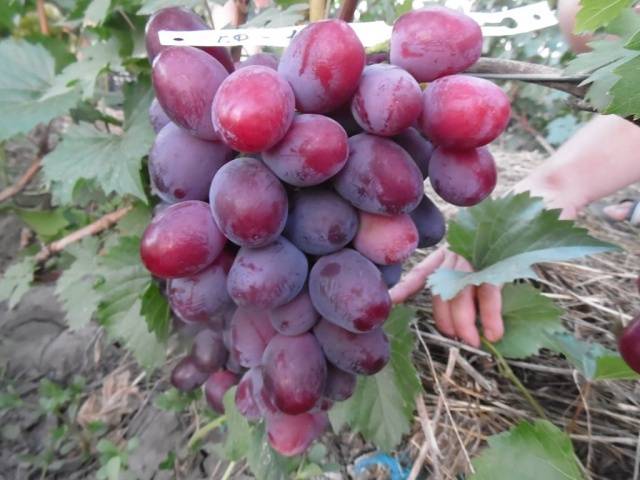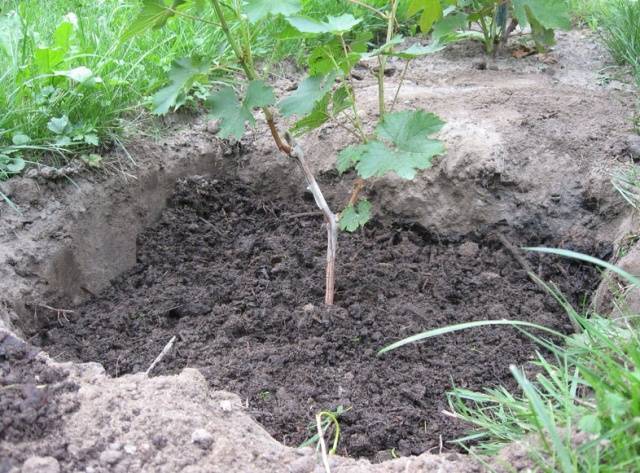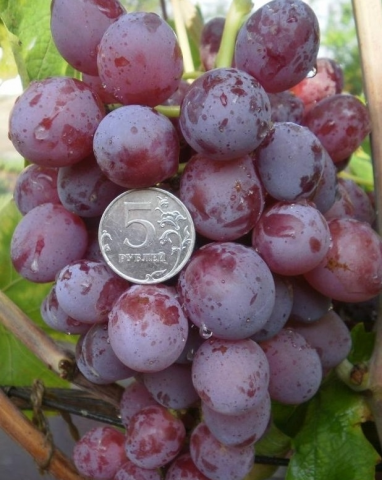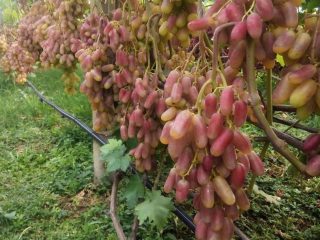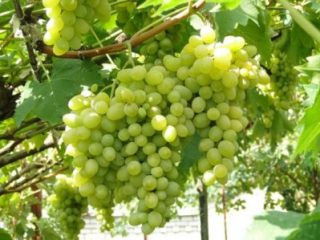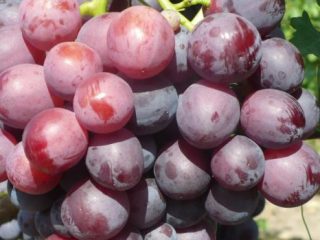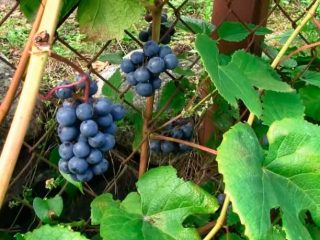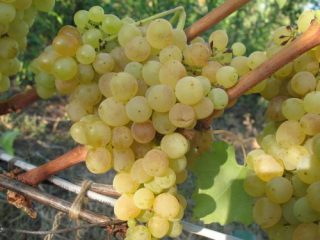Content
Everest grapes are a relatively new variety of Russian selection, which is only gaining popularity. The variety is characterized by the presence of large and tasty berries. The grapes grow quickly and produce a full harvest 3 years after planting. The berries ripen quite early. Below is a detailed description of the variety, reviews and photos of Everest grapes.
Botanical description
The Everest grape was bred by the famous breeder E.G. Pavlovsky by crossing the varieties Talisman and K-81. The hybrid ripens in the mid-early period - in the last ten days of August or September. The period from bud break to harvest is 110-120 days.
The Everest variety has a table purpose. The clusters are large, weighing 700 g, in the shape of a cone or cylinder, of medium density.
The bushes have great growth vigor and form powerful shoots. The flowers are bisexual, planting pollinators is optional.
Description of the variety and photo of Everest grapes:
- large berries;
- average fruit weight 12 g;
- oval shape of berries;
- red-violet color;
- thick waxy coating.
The berries are distinguished by their fleshy and juicy pulp. The taste is simple but harmonious. The fruits are not subject to rotting and cracking. Berries on one bunch may vary in size and color.
After ripening, the clusters can remain on the bushes for a month. After aging, the taste only improves, and nutmeg notes appear in the berries.
Everest berries are consumed fresh and used for making desserts, jams, and juices. The fruits tolerate long-term transportation well.
Planting grapes
The place for growing Everest grapes is chosen taking into account lighting, wind load, and soil fertility. Seedlings are purchased from trusted suppliers to prevent the spread of diseases and pests. Planting pits are pre-prepared, where mineral fertilizers or organic matter are added.
Selecting a location
A sunny area, protected from the wind, is allocated for the vineyard. When in the shade, the bushes develop slowly, and the berries do not gain sugar. It is better to arrange the beds on a hill or in the center of a slope. In lowlands where moisture and cold air accumulate, the crop is not planted.
In cool climate regions, Everest grapes are grown on the south side of a house or fence. This way the plants will receive more heat.
Bushes are placed at a distance of more than 3 m from fruit trees. The crown of trees should not cast a shadow on the vineyard. Fruit trees require a large amount of nutrients. Therefore, when planted close together, the grape bushes will not receive the necessary nutrition.
Growing green manure will help enrich poor soil before planting grapes. In spring, the soil is dug up and legumes, mustard, and peas are planted. The plants are watered regularly, and after flowering they are cut and buried in the ground to a depth of 20 cm.In the fall, planting work begins.
Work order
Everest grapes are planted in October or spring after the snow melts. It is preferable to carry out work in the fall so that the seedlings have time to take root before the weather gets colder.
Seedlings are purchased from nurseries. For planting, choose healthy plants that do not have cracks, dark spots, or growths on the roots. The optimal length of the seedling is 40 cm, the thickness of the shoots is from 5 to 7 mm, the number of buds is 3 pcs.
The grapes take root well both on rootstocks and on their own roots. In spring, planted bushes begin to actively develop and produce new shoots.
Grape planting procedure:
- Dig a hole measuring 60x60 cm to a depth of 60 cm.
- Place a drainage layer of crushed stone or expanded clay at the bottom.
- Prepare fertile soil, mix it with 3 buckets of humus and 2 liters of wood ash.
- Fill the hole with substrate and cover with plastic wrap.
- After 3 weeks, when the soil has settled, plant the grapes.
- Water the plant thoroughly.
During the first time after planting, water the Everest bushes every week with warm water. Mulch the soil with humus or straw to reduce the number of waterings.
Variety care
Everest grapes produce high yields with proper care. The plantings are watered, fertilized with useful substances, and the vines are pruned in late autumn. To prevent diseases and the spread of pests, preventive treatments are performed.
Watering
Young bushes of the Everest variety need intensive watering. Grapes under 3 years old are watered several times per season:
- in spring when buds open;
- before flowering begins;
- during harvest formation.
For irrigation, take warm water that has settled and warmed in barrels.Stagnation of moisture negatively affects the development of grapes: the roots rot, the development of the bush slows down, and the berries crack.
Mature grapes do not need constant watering. Its roots are capable of extracting moisture from the soil. In late autumn, bushes of any age are watered abundantly. The procedure protects the bushes from freezing and helps them survive the winter.
Feeding
Regular fertilizing ensures stable fruiting of Everest grapes. Natural and mineral fertilizers are used for processing. If useful substances were added to the soil when planting bushes, then fertilizing begins at 2-3 years.
Grape processing scheme:
- in spring when buds open;
- 3 weeks after flowering;
- when berries ripen;
- after harvest.
The first fertilizing is carried out in the spring using nitrogen fertilizers. The bushes are watered with mullein or bird droppings diluted with water in a ratio of 1:20. In the absence of natural fertilizers, 20 g of urea is incorporated into the soil.
In the future, nitrogen fertilizers are abandoned in favor of substances containing phosphorus and potassium. Phosphorus substances promote the accumulation of sugar in berries and accelerate the ripening of grapes. Potassium improves the resistance of fruits to rotting and improves their taste by reducing acidity.
After flowering, the plants are fed with a solution consisting of 100 g of superphosphate and 50 g of potassium salt. The substances are dissolved in 10 liters of water. The resulting solution is sprayed onto the plants over the leaves. The treatment is repeated when the first berries are formed.
In the fall, after the harvest, the soil in the vineyard is dug up and 2 buckets of humus are added per 1 square meter. m. Fertilizing helps restore the strength of the grapes after fruiting.
Trimming
Due to proper pruning, the Everest variety bush is formed.A total of 4 powerful shoots are left. The vine is cut to 8-10 eyes. The procedure is carried out in October after leaf fall. In the spring, the bushes are inspected and dry and frozen shoots are removed.
In the summer, the stepsons and leaves that cover the bunches from the sun's rays are plucked off. No more than 2 inflorescences are left for the shoot. Increased load leads to a decrease in the weight of the bunches and delays the ripening period of the crop.
Protection from diseases and pests
If agricultural practices are followed, Everest grapes remain resistant to major grape diseases. For prevention, plants are treated with a solution of Ridomil or Topaz. Ridomil is effective against mildew, Topaz is used to combat oidium and powdery mildew. The substances penetrate the above-ground parts of the grapes and protect them from the spread of fungus.
The procedure for treating grapes against diseases:
- in spring when the first leaves appear;
- a couple of weeks after flowering;
- after harvest.
If necessary, spraying is repeated, but not more than twice a month. The last spraying is carried out 3 weeks after harvesting the grape bunches.
The vineyard attracts gall midges, leaf and spider mites, leaf rollers, and beetles. The drugs Karbofos, Actellik, and Aktara work well against insects. Preventive spraying is carried out in spring and autumn. Chemicals are used with caution during the growing season.
Shelter for the winter
The Everest variety requires mandatory shelter for the winter. In the autumn, after the leaves fall, the vines are removed from the supports and laid on the ground. The culture tolerates temperatures down to +5 °C. If the temperature continues to drop, then it is time to cover the plantings for the winter.
The grapes are hilled and mulched with dry leaves.Wooden boxes or metal arches are installed on top. Agrofibre or burlap is used for shelter.
It is important for grapes to provide air exchange, so it is better to avoid using plastic film. Additionally, a snowdrift is thrown over the bushes in winter. In spring, the shelter is removed so that the vine does not rot.
Reviews from gardeners
Conclusion
Everest grapes are a promising variety that is gaining popularity among winegrowers and gardeners. The berries are used for table purposes and are large in size. Caring for the Everest variety includes watering and fertilizing. In the fall, they prune the vines and prepare the bushes for winter. When carrying out preventive treatments, grapes are not susceptible to diseases.
